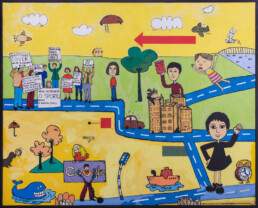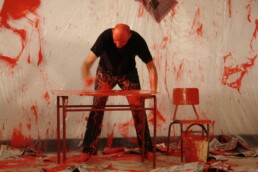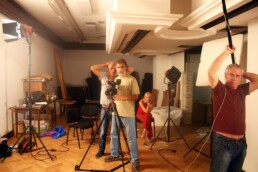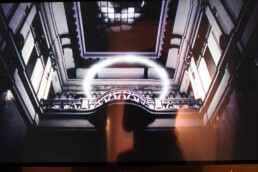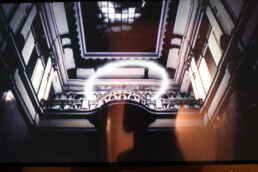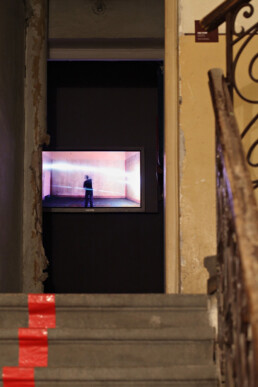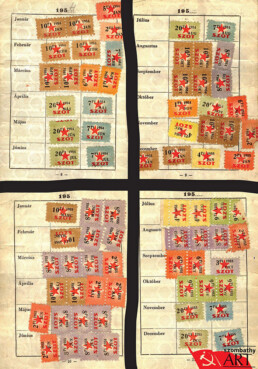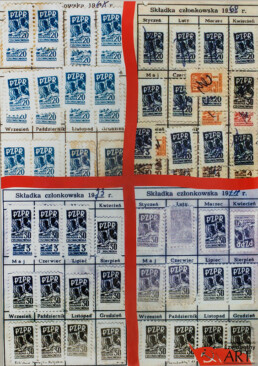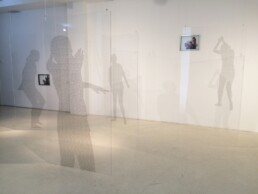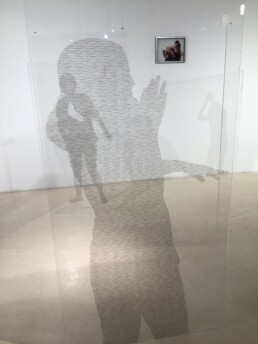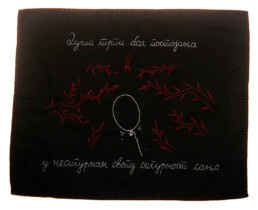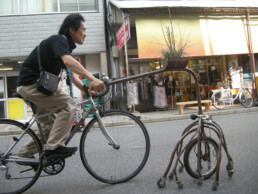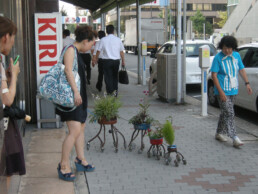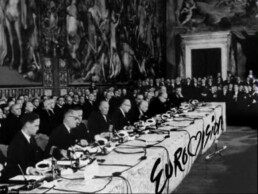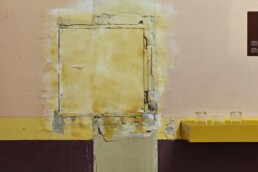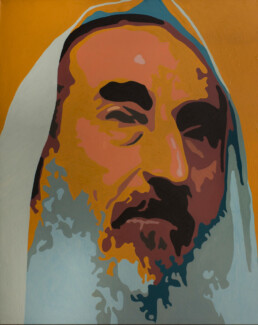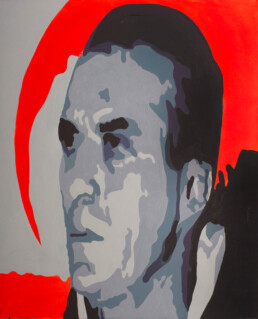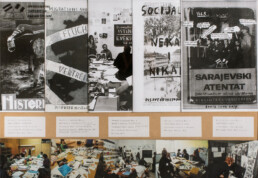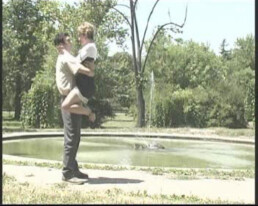Saša Stojanović
SAŠA STOJANOVIĆ (1968)
It Is Wrong to Think That You Will Understand It
oil on canvas
80 cm x 100 cm
2011
It Is Wrong to Think That You Will Understand It
oil on canvas
80 cm x 100 cm
2011
The work It Is Wrong to Think That You Will Understand It colourfully and “tamely” expresses the author’s dissatisfaction concerning the neoliberal and capitalist mechanisms and derivatives of spectacle and entertainment, which lead to atrophy in young people and to turning them into obedient elements of economy.
After the 2000s, Stojanović’s art practice has been directed against the consumer society and the neoliberal capitalist society that is driven by the economic interests of the minority and that produces poverty, sexism, marginalization, institutionalized violence and subordination of all kinds. In the work It Is Wrong to Think That You Will Understand It, attention is drawn to daily politics and the current reality; the painting contains messages that speak ironically about the socio-political everyday life. The group of people shown in the painting carry banners with messages such as: “Adapted man is not a free being”, “Robo Sapiens”, “The magic of how, where and why”, “Dogs used to look like their owners, now the owners look like their cars”, “In a variety of things, Capitalism, offers unfavourable loans”, “Ignoring is a new form of censorship”, etc. With his work, Stojanović proposes that we all should stop working on maintaining this false world and go to our own self-sustaining escapes, independent of the system. For him, art must not be intended for petty-bourgeois audiences and mediocrities, without any human and critical content.
© Cultural Centre of Belgrade, the October Salon Collection and the artist
Purchase Contract: III-5-381/16.11.2016.
Inventory No. 1459
Photo: Courtesy the artist
Selected Bibliography:
Saša Stojanović: Sloboda, Feb. 20 – Mar. 12, 2018, solo exhibition catalogue, City Gallery in Užice, 2018
Saša Stojanović: Nebesko pecivo, Apr. 9–27, 2013, text for the solo exhibition, Kolarac Gallery, Belgrade, 2013
ABOUT THE AUTHOR:
Saša Stojanović (1968, Leskovac, Serbia) is a visual artist, performer and activist. He graduated in painting from the Faculty of Arts in Pristina in 1997. His work is based on the affirmation of love and communication and a critical and self-reflexive attitude towards life, social reality and institutions. Performances realized during the 1990s and early 2000s, in the context of an engaged alternative, make a significant part of his opus. There is also a series of his lectures titled “Heavenly Pastry Listens to Records and Talks to People”, at which rock music by lesser-known musicians from the period 1966-1969 was played. He is the author of the poster and cover for the album “Luckily, General Loves Children” by the group Obojeni program and did graphic design for the book Three Knots on an Eyelash by Ljubivoje Ršumović. A member of ULUS (Association of Fine Artists of Serbia). In 2016, he realized the project Grail Library of Miracles with the Clio Publishing House, where he offers visual solutions that speak in a free spirit, opposing the banality of decorative consumer trends in book design.
Branimir Stojanović
BRANIMIR STOJANOVIĆ (1958)
Everybody Is Talking
video-film
455’
edition: 1/5
2009
Everybody Is Talking
video-film
455’
edition: 1/5
2009
Everybody Is Talking is a work that deals with the institutional history of ULUS (Association of Fine Artists of Serbia), i.e., the actual significance of this complex and endless network: of artists, art practices, art policies and strategies for maintaining the symbolic and social status of artists; a network that is unimaginable and inaccessible to the community, which – with not much enthusiasm – continues to provide funds for the status of a freelance artist.
Everyone Is Talking is a joint work of ULUS members. All members are invited to create, in the medium of the video installation, a utopian space of equal opportunities and the right to present their art and their views on art.
Namely, all ULUS members were invited to come to the premises of their art association – Cvijeta Zuzorić Pavilion – within a period of twelve days and, at the recording setting, in front of camera, express their views on art, that is, create a space of equality for everyone.
Branimir Stojanović, from the catalogue of the 50th October Salon
Consultant Director: Želimir Žilnik
Producer: 50th October Salon:
Co-producer: Academic Film Centre
Director of Photography: Miša Milošević
Editing, sound design and camera: Miloš Korać
Technical associate: Olivera Nastić
Branimir Stojanović and the artists: Milorad Mladenović, Dragan Marković-Markus, Srđan Vukajlović, Renata Bujić, Ljiljana Bursać, Budimir Dimitrijević, Marijana Karalić, Nadica Grbić, Radivoje Marković, Miroslav Prvulj, Vojin Rajović, Biljana Bakaluca, Marija Topalović, Slobodan Vuković, Jadranka Bežanović Sovilj, Maja Bekan, Balša Rajčević, Andrijana Bogdanović Nešković, Slobodanka Rakić-Šefer, Dejan Klincov, Mladen Tušup, Radiša Lj. Lucić, Gabriela Vasić, Vesna Milićević, Dragan Jevdić, Srđan Srećković, Dragana Pajković-Dodig, Milutin Jović, Vladimir Milošević, Jovan B. Zorko, Mirjana Radovanović, Vlastimir Madić, Olja Mićić, Dragan Vojvodić, Radisav Nasković, Dragoljub Tokić Drago, Tamara Miodragović, Lazar Dimitrijević, Milivoje Bogatinović, Marija Aleksandrović, Srđan Veljović, Bratislav Aleksić, Lidija Mićović, Verica Ilić, Milan Tepavac Tarin, Mina Minić, Srboljub Kojadinović, Vlado Njaradi, Tanja Nikolajević Veselinov, Svetlana Knežević, Selimir Selaković Sele, Dobrica Kamperelić, Zoran Vranešević, Mirjana Petrović, Lazar Lečić, Milica Raičević, Marija Jovanović, Biljana Cvetković, Goran Ostojić-Vid, Snežana Arnautović, Maja Rakočević Cvijanov, Edita Kadirić.
© Cultural Centre of Belgrade, the October Salon Collection and the artist
Gift Contract: III-5-294/29.9.2014.
Inventory No. 042
Photo: stills from the video work
Selected Bibliography:
https://pescanik.net/svi-govore/ Branislav Dimitrijevic
50th October Salon, Circumstance. Cultural Centre of Belgrade, 2009
ABOUT THE AUTHOR:
Branimir Stojanović (1958, Belgrade, Serbia) is a psychoanalyst, philosopher and artist. He is a member of the Belgrade Society of Psychoanalysts; the founder and a lecturer at the School of History and Theory of Painting; founder and publisher of the Gray Science Book Series and the Prelom Magazine; editor-in-chief of the Arhiva psihoanalize Journal and the founder and member of the Spomenik Group, and also the founder and a member of the library and self-educational institute Učitelj neznalica i njegovi komiteti [Ignorant Schoolmaster and His Committees]. He has published essays, texts and studies in the fields of philosophy, psychoanalysis theory, critique of ideology and art theory.
Samuil Stoyanov
SAMUIL STOYANOV (1975)
10 min Geozavod
video
10’25”
edition: 2/5 + 1 a.c.
2012
10 min Geozavod
video
10’25”
edition: 2/5 + 1 a.c.
2012
The work was created for the needs of the 53rd October Salon and filmed in the exhibition space of the Geozavod Building in Belgrade.
During his stay in Belgrade, Samuil recorded himself as he was spinning a light bulb (on a cord) over his head in an empty room of the Geozavod Building, non-stop for ten minutes. This work is the first in the series of site-specific portraits of space, which, after Belgrade, the artist realized in the Museum of Natural History in Sofia.
By disabling all sources of light – natural or artificial – that would clearly identify the space in which he is, the artist actually creates his own cosmos. As he spins the light bulb over his head, he is referring to movement in space. On the one hand, he takes on the role of a pseudo-scientist performing an experiment, and on the other, he becomes a black hole that keeps the orbit around in motion. Wondering where the space of art is, he opens the topic of the so-called “thinking vision”. To think while looking or to look while thinking is a process that is primarily related to the conceptualization of a visual action, that is very often related to the number 10, which refers to a certain period of time, but can always be longer.
© Cultural Centre of Belgrade, the October Salon Collection and the artist
Gift Contract: III-5-297/29.9.2014.
Inventory No. 1365
Photo: still from the video work
ABOUT THE AUTHOR:
Samuil Stoyanov (1975, Dobrich, Bulgaria) is a visual artist who lives and works in Dobrich, Bulgaria and Arusha, Tanzania. He graduated from the National Academy of Arts in Sofia. In 2010, he was a resident artist at the International Studio and Curatorial Program ISCP in New York. In 2011 he won one of the most important awards for contemporary visual art in Bulgaria, RUF. In the jubilee issue of the art magazine Frieze, Samuil’s work was presented by Nedko Solakov, and he is one of the artists included in the book on avant-garde art in Bulgaria The Bulgarian Nouvelle Vague. More information at https://openartfiles.bg/en/people/2394-samuil-stoyanov
SZOMBATHY BÁLINT
SZOMBATHY BÁLINT (1950)
We Were Heroes – Slovakia
digital print
70 cm x 49 cm
2011
We Were Heroes – Poland
digital print
70 cm x 49 cm
2011
We Were Heroes – Hungary
digital print
70 cm x 49 cm
2011
We Were Heroes – Slovakia
digital print
70 cm x 49 cm
2011
We Were Heroes – Poland
digital print
70 cm x 49 cm
2011
We Were Heroes – Hungary
digital print
70 cm x 49 cm
2011
The works We Were Heroes (Slovakia, Poland, Hungary) are part of the Millennium Paintings Series of digital works, which Szombathy started in 2000. The artist collaged discarded communist objects, such as party booklets, membership cards of various organizations and stamps. He took over the pages from the membership booklets without intervention, but intervened in each composition by drawing a cross, as a symbol of suffering of the victims of the previous system. For Szombathy Bálint, art manifests itself as a personal archive – where various ideals, images, memories, knowledge, restrictions or taboos are placed. Due to such procedure, the works We Were Heroes (Slovakia, Poland, Hungary) are perceived as disturbing elements of the new transitional realities of ex-socialist peoples.
In We Were Heroes (Slovakia, Poland, Hungary) Szombathy Bálint, with complex relationships (art-culture-society-politics-ideology) thematizes today’s search of the Eastern European man (being in the gap between the post-socialism legacy and uncritically accepted /disguised/ reprisals of post-capitalism) for new and different identities. Szombathy collected and bought party booklets, membership cards and stamps in the underground passages upon his arrival in Hungary, where he noticed the incredible desire of people to give up material memories from the time of communism. The artist was especially interested in stamps, in whose strong graphic potential he found a kinship with the pop art iconography. Szombathy’s works are characterized by the presence of a dose of nostalgia – in recent decades more and more present among ex-Yugoslav peoples who, pressed by slow acclimatization to the market rules of (liberal) capitalism, have become aware of the advantages of Yugoslav multiculturalism as their own small-scale European Union.
© Cultural Centre of Belgrade, the October Salon Collection and the artist
Purchase Contract: III-5-4/12.1.2015.
Inventory No. 073, 074, 075
Photo: Milan Kralj
Selected Bibliography:
Balint Sombati, Bili smo heroji, Sept. – Dec. 2014, exhibition catalogue, Likovni susret Modern Gallery, Subotica, 2014
Guided tour of the exhibition We Were Heroes, SEEcult.org, 2014, https://www.youtube.com/watch?v=QhQ0BepPP7E, accessed on Mar. 27, 2020
Balint Sombati, Bili smo heroji, Sept. – Dec. 2014, exhibition blog, http://bilismoheroji-likovnisusret.blogspot.com/, accessed on Mar. 27, 2020
ABOUT THE AUTHOR:
Ivana Smiljanić
IVANA SMILjANIĆ (1980)
You’ll Remember Me
installation – drawings, acrylic panels (print on PVC foil), sound (mp3 file, DVD carrier)
various dimensions (5 pcs); 90 cm x 190 cm (4 pcs); 91’
2013–2016
You’ll Remember Me
installation – drawings, acrylic panels (print on PVC foil), sound (mp3 file, DVD carrier)
various dimensions (5 pcs); 90 cm x 190 cm (4 pcs); 91’
2013–2016
With the installation You’ll Remember Me, which consists of subtle drawings, transparent foils, sound and some of her intimate notes, the author wants to give physical form / make visible what most often eludes us, because it leaves no physical trace: full force of psychological violence in partnerships. Visually, the work is a composition of drawings and acrylic panels (Plexiglas) showing female figures in motion, cut out from the photo documentation of the dance performances I Dance Dance Dance. The figures are carefully chosen so as not to indicate dance moves and arranged so that it is not clear whether they are defending, attacking, confiding in each other, dance together or each on their own.
The work was exhibited at the 54th October Salon.
Each figure (transparent PVC foil lined on acrylic panel) is covered with text in fine print – excerpts from the so-called “diary of insults” – the sentences written by the artist during her traumatic personal experience or, rarely, heard on the street or in public transport (one figure – one sentence, infinitely multiplied). Taken out of the context, they are banal, ambiguous or witty (“you made it up nicely”, “you think if you’ve married you are secure”, “you will remember me”, “be grateful to be with me”…).
Acrylic panels can lean against the wall (giving the impression that the text is on the wall) or placed (hanging) in the space, in several planes, making the composition more complex.
The figures in the drawings are also created using templates from dance photographs. They are covered with stamp imprints – words: I want, I grow, I wish, I dance, I can, I blossom – with the idea to empower and encourage the women who recognize themselves to leave their violent partners. Tempera and acrylic paint were used instead of stamping ink, and the contours were drawn in various pencils or markers. Self-adhesive transparent foils were also used, glued directly to paper or to the inside surface of the glass, in the process of framing.
Sound is an important part of the setting: at rare intervals, every 15 minutes, the author announces herself by uttering one of the sentences from the “diary of insults”, but only those few that directly insult, humiliate and threaten the integrity of the addressed person (“you incapable shit”, “you disgust me”, “I shit on your dignity”, “your tits are nothing”, “whore”…). The sentences are spoken word for word, with no expression, inconsistent with the meaning, so they sound vague, like a language course or a talk machine. The role of the sound is to inform the visitors about the seriousness of the topic, to help them see the whole composition, apparently gentle and bright, from another angle.
© Cultural Centre of Belgrade, October Salon Collection and the artist
Purchase Contract: III-5-386/16.11.2016.
Inventory No. 1451
Photo: installation view 54th October Salon, Ana Kostić
ABOUT THE AUTHOR:
Ivana Smiljanić (1980, Belgrade, Serbia) graduated (in 2005) and received her master’s degree (in 2009) from the Faculty of Fine Arts in Belgrade. As a scholarship recipient of KulturContact (Vienna) and SSA (Salzburg), she attended video and performance classes at the Salzburg Summer Academy of Fine Arts in 000 and 2002. She completed Women’s Studies Programme at the Centre for Women’s Studies in Belgrade (2012/13). Using different media and resources of her own body, she deals with re-creating / re-interpreting of the experiences / phenomena / problems she encounters as a woman, artist and citizen. She has had solo exhibitions and performances in Belgrade, Novi Sad, Pančevo, Prijepolje, Smederevo, Vranje, Zagreb, Osijek, Pula, Ljubljana, Bratislava, Brussels, Bergen and New York, participated in the 49th and 54th October Salons, and in more than sixty group exhibitions in the country and abroad. She won Henkel Art Award for Serbia in 2011 and Dimitrije Bašičević Mangelos Award in 2009, which included her involvement in the International Studios & Curatorial Program in New York. Her works are part of the Telenor Collection. More information at www.ivanasmiljanic.com
Škart
Škart
Like a comet, the manager falls down to land, felled by a worker’s mighty hand
text, drawing and embroidery: Lenka Zelenović
40 cm x 35 cm
2006
From your terrace, rubbish do not dump, or everyone will see you’re a slovenly frump
text, drawing and embroidery: Lenka Zelenović
47 cm x 30 cm
2007
Everyone wants to go very fast, till the end of our lives we’ll surely last
text and embroidery: Brigita Međo
drawing: Vladan Nikolić
68 cm x 45 cm
2012
The pain of existence makes the soul burst at the seams, in an uncertain world, of safety it dreams
text and embroidery: Brigita Međo
drawing: Vladan Nikolić
68 cm x 55 cm
2012
Dish-Familysh, Bush-o-Rush
Plant-o-biles Serie
ambiental mobile installation
variable dimensions
2010
New embroideries
series of embroidery on canvas
Like a comet, the manager falls down to land, felled by a worker’s mighty hand
text, drawing and embroidery: Lenka Zelenović
40 cm x 35 cm
2006
From your terrace, rubbish do not dump, or everyone will see you’re a slovenly frump
text, drawing and embroidery: Lenka Zelenović
47 cm x 30 cm
2007
Everyone wants to go very fast, till the end of our lives we’ll surely last
text and embroidery: Brigita Međo
drawing: Vladan Nikolić
68 cm x 45 cm
2012
The pain of existence makes the soul burst at the seams, in an uncertain world, of safety it dreams
text and embroidery: Brigita Međo
drawing: Vladan Nikolić
68 cm x 55 cm
2012
The works from the New Embroideries Series were exhibited at the 48th October Salon, Micro-Narratives. The Škart Group won the 48th October Salon Award for this work.
In the summer of 2000, we took courage to encourage several women’s groups to, after a century and a half of transcribed embroideries, put their own views and doubts on canvas. Since then, embroideries have emerged that no longer deal only with the idyllic image of an obedient, God-fearing, naive housewife, but also with the readiness to face family, social and political prejudices.
Small is big. Kitchen whispers are remembered longer than school dictations. New embroideries are here to replace the wrong ideas.
Škart, from the catalogue of the 48th October Salon
The initiative with New Embroideries gave new life to the traditional embroideries, which, besides the walls in households, find their place in art galleries, and give various authors who create them the opportunity to become equal actors on the contemporary art scene. Lenka Zelenović, one of the most prominent members of the Škart Group, has so far made hundreds of them, with different motives and messages, referring to the critique of the local political situation, ecological and emotional messages.
© Cultural Centre of Belgrade, the October Salon Collection and the artists
Gift Contract: III-5-291/1/25.9.2014.
Inventory No. 1354, 1355, 1356, 1357Photo: Courtesy of the artist, Milan Kralj
Selected Bibliography:
48th October Salon, Micro-Narratives. Cultural Centre of Belgrade, 2007
Nove kuvarice umjetničke grupe Škart, Vox Femine, Oct. 29, 2012, https://voxfeminae.net/vijesti/nove-kuvarice-umjetnicke-grupe-skart/ (accessed on Apr. 26, 2020)
Iva Parađanin, “Feministički i borbeni vezovi žena Srbije”, VICE, May 18, 2017, https://www.vice.com/rs/article/gvzkey/feministicki-i-borbeni-vezovi-zena-srbije (accessed on Apr. 26, 2020)
Dish-Familysh, Bush-o-Rush
Plant-o-biles Serie
ambiental mobile installation
variable dimensions
2010
Plant-o-biles is part of a larger installation, i.e., the exhibition titled Seesaw Play-Grow (a polygon of imbalance), which the Škart Group made for the Serbian Pavilion at the 12th Biennial of Architecture in Venice in 2010.
It consists of two families: the sneaking family and the rolling plant.
Seesaw Play-Grow is a metaphor of space, which with its dynamics and contrast should provoke the viewer to find answers to questions about the essence of the work. Like Seesaw Play-Grow, Plant-o-biles also re-examines the relationship between the urban environment and nature. Plant-o-biles, as a kind of counter-object, calls for play and dialogue.
It reflects on the relationship between the urban environment and nature and is inspired by Vasko Popa’s Metropolis Poem: My wife, who I would do anything for, told me once, I would like to have a small green tree that would run after me down the street!
© Cultural Centre of Belgrade, the October Salon Collection and the artists
Purchase Contract: III-5-497/1/22.12.2014, III-5-498/1/22.12.2014.
Inventory No. 1387, 1388
Photo: Courtesy the artists
Selected Bibliography:
Škart: Poluvreme, Oct. 9–26, 2012, catalogue of the retrospective exhibition, Museum of Applied Arts, Belgrade, 2012
ABOUT THE AUTHORS:
Škart is a collective founded in 1990 at the Faculty of Architecture in Belgrade. The group consists of architects-designers Đorđe Balmazović Žole (1965, Belgrade, Serbia) and Dragan Protić Prota (1965, Zrenjanin, Serbia) with the occasional participation of various artists, colleagues, acquaintances, craftsmen or amateur poets. Their art is created on the borders of activism, poetry, music, architecture, fine and applied arts. A wide field of activity enables the members of the group the “social production of space”, i.e., a unique impact on the society in which they act, within the art system or completely outside it. The group’s activities in urban environments, as well as in outlying areas, show courage and inventiveness, with a certain dose of lucidity and activist humour, which are the elements of this collective’s aspiration to deal with some issues of modern society in a witty and analytical way. The first decade (1990 – 2000) was marked by “samizdat” books and their distribution in the street actions. In the second decade (2000 – 2010), the group co-founded several new collectives: the choirs Horkeškart and Proba, children’s choirs Deca sa meseca and AprilZMAJun, the youth-retired person’s choir HOR-RUK and the antifascist choir UHO (united choirs). Since 2010 the collective has been increasingly involved in working with children (at the “Vera Radivojević” Children’s Home in Bela Crkva) and with retired people. They have exhibited as a group and individually at numerous exhibitions in the country and abroad. In 2010 they represented Serbia at the Venice Biennale of Architecture. Мore information at www.skart.rs
Dubrаvkа Sеkulić
DUBRAVKA SEKULIĆ (1980)
Old Gal
installation, sound
variable dimensions
2012
Magic in the Air (Eurovision, Television, Europe)
video (DVD)
8’3”
2010
Old Gal
installation, sound
variable dimensions
2012
1) Take a glass
2) Find the place where the sound is best
3) put the edge of the glass against the wall
4) bring the ear to the bottom of the glass and listen
The instructions that accompany the presentation of the work, produced for and exhibited at the 53rd October Salon, made it possible to hear the audio recording of the story Old Gal, related to the history of the former Geozavod Building in Belgrade, where the exhibition was held.
A Part of the Story
Once upon a time there was a house. The house everyone called “the most beautiful house in the town”. The most beautiful house that nobody saw from the inside, at least not intentionally. So, how can anyone say that it is the most beautiful house if they haven’t walked its corridors or at least climb its stairs, seen its interior, I ask you. Don’t they know that the beauty of a house comes from the inside? When one approaches me, one is confronted with broken windows, and starts wondering… is this really the most beautiful house in the town? How can this be… it is difficult to understand what I am. One might say that I have something like an identity crisis. It’s been a while since things actually made sense… See, I was created for a completely different time and position in society…
(…) But let me tell you my story from the beginning… This neighbourhood was of utmost importance when I was erected. I stood tall and shone, I was the promise of a future prosperous society that was being built across the river from the great empire. I was sending a message – what you across the street can do, I can do also. I was built to perform an important function in that society to be the centre of its future finances, right there, on the border. What an illusion of grandeur, what a decoration it was… but I will tell you about this later. I was always proud, at least in the first decades of my life, of the fact that I was built as an act of generosity, as a gift of a wealthy person with a vision to society. I felt special. Of the few that were created in the same manner, I was the most beautiful and luxurious. But – and here I risk sounding like my good old pal Wooster – what was more important than decoration was the sense of importance. I was built to be the centre of economy and future finances. The heart of an important capitalist country. In an affluent neighbourhood. One look from across the street, from the Bristol Hotel, would make my body shiver with anticipation of the good life that was to come. Well, that was a mistake. In my, hm, hm, years, one thing I was repeatedly convinced of was that plans usually are made for one direction, and reality goes the other way. Nothing expresses that better than the current broken windows (…)
Dubravka Sekulić
© Cultural Centre of Belgrade, October Salon Collection and the artist
Gift Contract: III-5-246/28.8.2014.
Inventory No. 1342
Photo: Cultural Centre of Belgrade’s archive, Ana Kostić
Selected Bibliography:
53rd October Salon, Good Life: Physical Narratives and Spatial Imaginations. Cultural Centre of Belgrade, 2012
Magic in the Air (Eurovision, Television, Europe)
video (DVD)
8’3”
2010
An ironic video collage of pop culture images, a story of post-World War II development of Europe from two unexpected perspectives. One follows the story of the Eurovision Best Song Contest and the other, the standardization of television, questioning their status as “neutral” phenomena. Is Europe based on a control system and are its technological standards neutral?
1956 Launching of the Eurovision Song Contest
1957 Signing of the Treaty of Rome
1961 Yugoslavia joins the Eurovision Song Contest
1968 First Eurovision in colour broadcast from London in PAL encoding system
1973 Israel joins Eurovision
1980 Morocco participates in Eurovision for the first and last time
1989 Yugoslavia, the only communist country in the contest, wins Eurovision
1990 The song Insieme, unite, unite, Europe wins at Eurovision in Zagreb
1991 Disintegration of Yugoslavia
1992 Signing of the Maastricht Treaty
1993 Upon entry into force of the Maastricht Treaty, the European Union was created
1994 Seven countries of the former Eastern Bloc, headed by Russia, join Eurovision
1994 The countries of the former Eastern Bloc begin to adapt their TV encoding system, transitioning from SECAM to PAL
2000 Turkey wins Eurovision and local politicians exclaim that Turkey is now closer to the European Union
2005 The European Broadcasting Area expands to Caucasus countries
2006 Armenia joins Eurovision
2000 Georgia joins Eurovision
2007 First digital broadcast of Eurovision from Helsinki
2008 Azerbaijan joins Eurovision
What are the rules for defining Europe?
And what is European?
Are technical standards neutral?
How do they influence physical and symbolic space?
What is the connection between the development of Europe, TV broadcast and Eurovision?
© Cultural Centre of Belgrade, October Salon Collection and the artist
Purchase Contract: III-5-518/24.12.2014.
Inventory No. 1393
Photo: still from the video work
ABOUT THE AUTHOR:
Dubravka Sekulić (1980, Niš, Serbia) is an architect-researcher. She graduated from the Faculty of Architecture, University of Belgrade, and the Design Department of the Jan van Eyck Academy in Maastricht. From 2003, she worked at the Faculty of Architecture, Belgrade University, with Professor Ivan Kucina, as a teaching assistant for various programmes, mainly dealing with cooperation with other schools. Since 2007, she has been the executive editor of the Anchor School Magazine. She collaborated with the Zagreb group Platform 9.81 and, during 2004 and 2005, was part of the group that ran the BIGZ alternative space in Belgrade. Since 2016, she has been an assistant at the Institute of Contemporary Art in Graz.
Vladislav Šćepanović
VLADISLAV ŠĆEPANOVIĆ (1971)
In Anticipation of Imam Mahdi (Mula Omar, Sheikh Yassin and Zvezdan Jovanović)
oil on canvas
100 cm x 80 cm (3 pcs)
2003–2004
In Anticipation of Imam Mahdi (Mula Omar, Sheikh Yassin and Zvezdan Jovanović)
oil on canvas
100 cm x 80 cm (3 pcs)
2003–2004
The installation In Anticipation of Imam Mahdi consists of 12 portraits of internationally proclaimed war criminals, painted in the recognizable pop-art manner, with the halos of saints above their heads.
The work was exhibited at the 45th October Salon: Continental Breakfast (2004), at the invitation of Art Director Anda Rottenberg. Several months earlier, the planned exhibition of the works at the Progres Gallery in Belgrade had been banned shortly before the opening.
Portraits of the declared war criminals, such as Bin Laden, Saddam Hussein, Mula Omar, Fidel Castro, Mao Zedong, Sheikh Yassin and Ruhollah Khomeini, include those connected to the war in the former Yugoslavia during the 1990s: Željko Ražnatović Arkan, Slobodan Milošević, Zvezdan Jovanović and Radovan Karadžić (some of whom were alive at the time the work was created). Choosing these personalities, the artist wonders about the credibility of the dominant views and the power of media images that reflect the power of capital and the ruling economic and political structures. He also wonders whether it is possible to restore the referentiality of man as a thinking subject. The idea of humanism and of democracy that has turned into its surrogate, and his personal stance on the fight against terrorism today, are some of the main topics addressed in these works.
© Cultural Centre of Belgrade, October Salon Collection and the artist
Gift Contract: III-5-218/14.8.2014.
Inventory No. 1337
Photo: Milan Kralj
Selected Bibliography:
45th October Salon, Continental Breakfast. Cultural Centre of Belgrade, 2004
Marija Đorđević, “Papa pokriven kaputom”, Politika, Belgrade, 09.2.2008, KD6, http://www.newpolis.org/meta-content/uploads/2015/10/Kulturne-veze-Srbija-Kosovo-2008.pdf – accessed on March 10, 2020.
Vladislav Šćepanović, “Mediji, estetika i destrukcija”, Collection of Papers, Faculty of Dramatic Arts, No. 16, Belgrade, 2009, 129–141
ABOUT THE AUTHOR:
Vladislav Šćepanović (1971, Nikšić, Montenegro) graduated from the Faculty of Fine Arts, Cetinje, received his master’s degree and doctorate in interdisciplinary doctoral studies from the Faculty of Applied Arts in Belgrade. In his art, he deals with the world of simulation and the operations of the forces of domination and resistance in the mass media of spectacle. His main motive is the exploration of media scenes that are an open portrayal of the power of capital and the ruling economic and political structures. He is one of three artists who represented Serbia at the 57th Venice Biennale. He is a professor at the Faculty of Applied Arts in Belgrade. More information at vladscepanovic.com
Vahida Ramujkić
VAHIDA RAMUJKIĆ (1973)
Disputed Histories
digital and offset prints
variable dimensions
2012
Disputed Histories
digital and offset prints
variable dimensions
2012
The work Disputed Histories is a long-term project of public lectures, workshops and discussions that directly deal with the problem of writing and teaching history in primary and secondary schools in the former Yugoslavia.
After the disintegration of Yugoslavia, various versions of historical narratives appeared in the new states, where during socialism there was only one version of history.
The aim of this project is to explore, through creative practices and processes, the historic shift in the interpretation of historical events from the perspective of individual histories and identities and to open space for thinking of new positions from which more consistent historical narratives could be perceived.
The work in the Collection consists of five volumes / fanzines framed together with photo-documentation of the workshops held in Banja Luka (Vol. 1: “Our Latest Hysteria”, a compilation of history textbooks for the eighth grade of primary school in Bosnia and Herzegovina, Croatia and Serbia, 2010), Berlin. (Vol. 2: “Migrations and Expulsions”, a comparative analysis of the data on migrations and expulsions of people during the Yugoslav wars in the 1990s, found in history textbooks in the countries of the former Yugoslavia and Germany, 2011), 52nd October Salon in Belgrade (“Istina / Evërteta” [truth in the Serbian / Albanian language], comparative analysis of Kosovo and Serbian history textbooks, 2011), Rijeka (Vol. 4: “Socialism Then and Never”, 2013) and, again in Banja Luka, in 2014 (Vol. 5: “Sarajevo Assassination”, through the doctrinaire eyes of the textbooks in Bosnia and Herzegovina, Croatia, Serbia, Yugoslavia, Austria, etc.).
© Cultural Centre of Belgrade, October Salon Collection and the artist
Purchase Contract: III-5-163/27.5.2016.
Inventory No. 1419
Photo: Milan Kralj
Selected Bibliography:
All the material related to the Disputed History Project, documentary material, list of textbooks and more detailed information can be found at http://www.irational.org/vahida/history/
ABOUT THE AUTHOR:
Vahida Ramujkić (1973, Belgrade, Serbia) graduated from the Faculty of Fine Arts in Belgrade. From 1998 to 2007, she stayed in Barcelona, where she founded the Rotor Collective, which conceives its research on the border of art, activism and social studies. She is the author of various projects, such as Disputed Histories, Documentary Embroidery, Microcultures, etc. In many years of her work in the spheres of visual arts and activism, Vahida Ramujkić has dealt with social relations and the relations with the material environment, creating the conditions for designing of methodologies for collaborative learning and working. Therefore, she often works within a collective (Rotor, Barcelona, 2001–2007; Irational.org, transnationally, since 2012, ReEX, since 2015, Minipogon, since 2017, etc.) and develops her work through long-term research projects. She often uses the inclusive method and open structure to invite the participants to involve in the collective work, formed like a mosaic from individual interventions and solutions. In that sense, her work is rather environmental or contextual in nature – it creates conditions or situations to inspire new creative moments and transformations at the personal and social level. More information at http://www.irational.org/cgi-bin/vahida/projects/index.pl
Maja Rakočević Cvijanov
MAJA RAKOČEVIĆ CVIJANOV (1975)
Lucky Couples
video
9ʼ45”
edition: 2/5
2003–2004.
Couple in Transition
sculpture, bronze
2013
Lucky Couples
video
9ʼ45”
edition: 2/5
2003–2004.
The work is about deconstructing the process of creating a fantasy of love and happiness. Such fantasies are stereotypes created under the influence of the mass media, films, commercials and magazines.
Responding to the stereotypes that digital media produce when it comes to the idealized image of a “happy couple”, the artist assumes various roles, imitating certain situations that she recognizes as typical. The work is also connected with the series of digital prints with the same title and theme. Scenes of couples where a happy ending is the only certainty underline the ideology of consumerist culture.
At the 45th October Salon, she exhibited the work A Head of Sugar, a stylized sculpture in the shape of a human heart in the size of a head, made of sugar.
© Cultural Centre of Belgrade, October Salon Collection and the artist
Gift Contract: III-5-286/1/22.9.2014.
Inventory No. 1346
Photo: still from the video work
Couple in Transition
sculpture, bronze
2013
Couple in Transition represents a male–female couple as a by-product of a failed transition. It is part of the Status Symbols Series, created through modifying children’s toys – superheroes, jeeps, castles and animals.
On the pedestal, as is the case with celebrities, there is a female character in which we recognize a Barbie doll upgraded with implants, while the male character, Venom, is dressed in a formal jacket. The interventions that the artist applied to both characters speak in favour of status symbols that, during the period of unsuccessful economic transition and throughout the 1990s in Serbia, made values such as education, culture and humanity completely senseless.
Couples like that could be found in different periods, and we can recognize the successors of those from the 1990s, three decades later, in starlets, entertainers and offenders who are latently associated to politics.
© Cultural Centre of Belgrade, October Salon Collection and the artist
Purchase Contract: III-5-480/1/15.12.2014.
Inventory No. 1384
Photo: Milan Kralj
ABOUT THE AUTHOR:
Maja Rakočević Cvijanov (1975, Subotica, Serbia). She graduated in sculpture and received a master’s degree from the Faculty of Fine Arts in Belgrade. She has participated in numerous group exhibitions, workshops and symposia in Serbia and abroad. She works as a sculptor-conservator at the Inter-municipal Institute for Protection of Cultural Monuments in Subotica and teaches sculpture at the Secondary Polytechnic School in Subotica; the author of five public monuments on the territory of Subotica, where she lives and works.

